The VPK-7829 Bumerang is a modern amphibious armored personnel carrier (APC) developed by Russia, designed to replace legacy Soviet-era BTR-60/70/80s in the Russian military. The Bumerang was designed as amodular platform and new family of wheeled combat vehicles for different configurations and roles on the battlefield. It was to be declined into an infantry fighting vehicle, command vehicle or ambulance as base versions. Base armament is a 30mm automatic cannon, coaxial 7.62mm machine gun and ATGMs, and features advanced composite armor with an active protection systems (APS) againsty ATGMs. It is an amphibious vehicle, with a a crew of three (commander, driver, and gunner) and eight fully equipped infantry and featuring modern communication, navigation, and fire control systems to enhance situational awareness and coordination on the battlefield. It was first revealed in the 2015 red square parade, but yet to be seen fielded to any unit.
In November 2011, media reported the new project was approved and on 21 February 2012, Col. Gen. Alexander Postnikov affirmed the first deliveries of the Bumerang prototypewere expected in 2013 with first production batches scheduled in 2015 with 2,000 on rder to replace the BTR-80 and BTR-82/A. The new Bumerang was first seen in public with its turret and cannon shrouded in the 2015 May parade rehearsals but soon delays amounted, and the date of completion for the preliminary and state trials were pushed back. In 2015 first preliminary trials were announced started, but this was reported still the case by 2018 with a new completion for the end of the year.
In 2020 state trials were announced ongoing with a completion the next year and production granted in 2022. Reasons given were that preliminary trials of 2019, revealed many issues and it decided to make changes to the main body in order to improve internal ergonomics and troop compartment space and safety, but also the deficient buoyancy. However as of April 2023, state tests were still at military training ground stage, with "seven vehicles" tested. Tests were scheduled for completion by the end of 2023, for production to be greenlighted.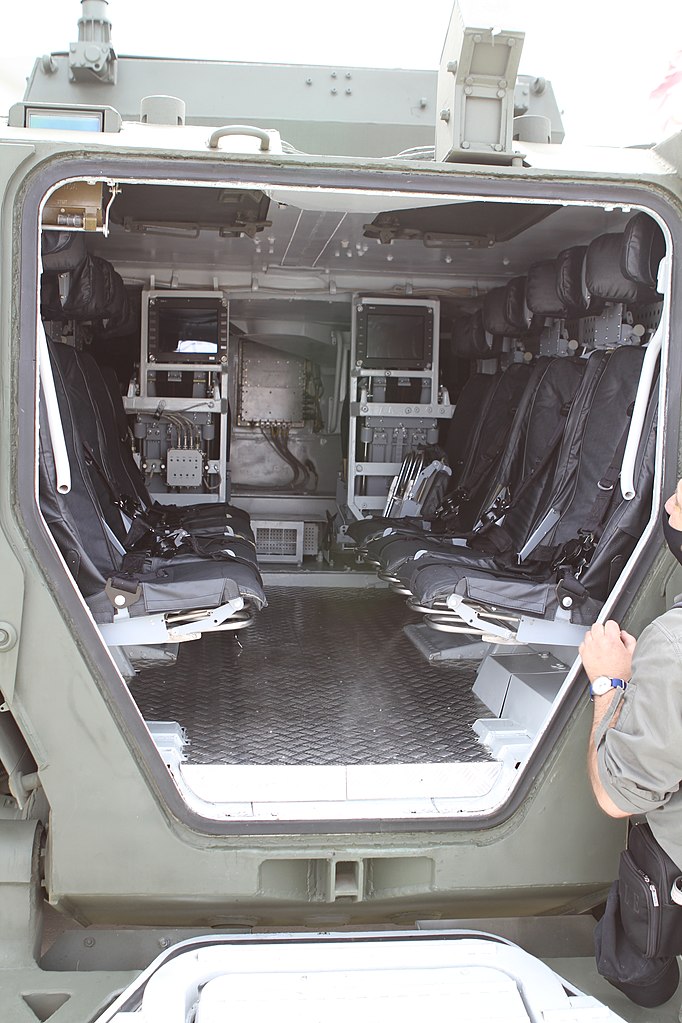
Interior
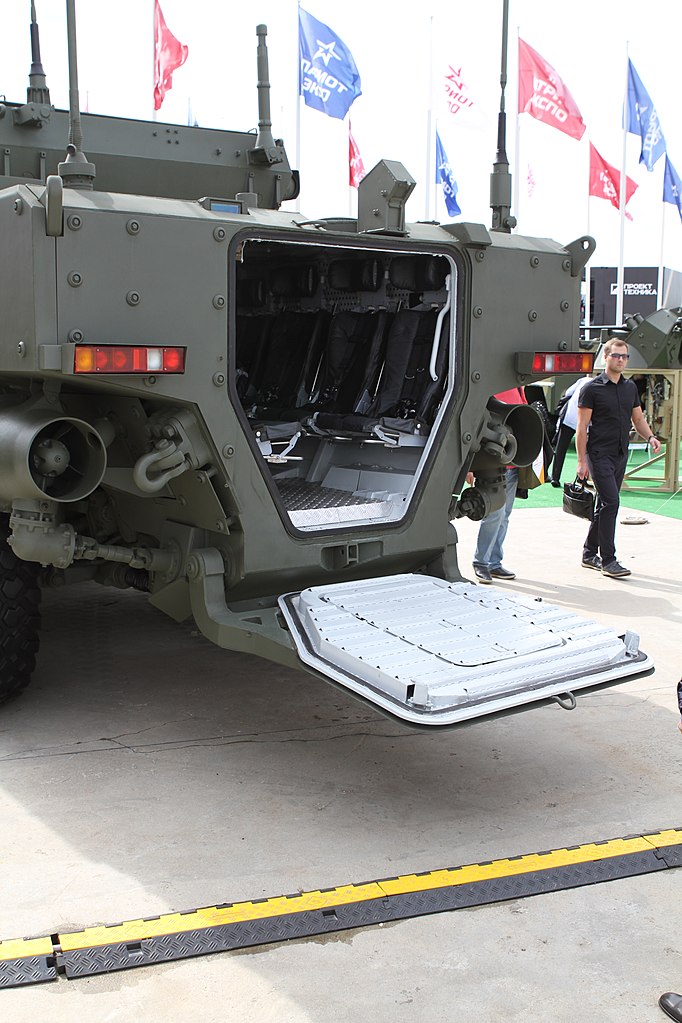
Rear door open

Commander station
The Bumerang is part of the "Armata Universal Combat Platform". It is amphibious, having enough buoyancy and two waterjets. This is a completely new design compared to the BTR-90 and previous BTR series, with the engine in the front-left, driver on the right, and instead of side doors, rear doors and roof hatches for troop entry and exit. The basic crew of three comprises a driver in the hull, gunner, and commander in the turret. The rear compartment was supposed to carry eight, then it was reduced after trials to seven troops. Protection is supposed to be composed of ceramic armor with addon bolted panels to avoid shell splinters.
Externally, the vehicle resemble western APCs, such as the Patria AMV. There is a beak-like nose comprising a lower angular plate with the lights in recessed either side, no proper bumber, and an upper nose with a much steeper angle, comprising the trim vane. Ther are two "rear mirror trees" on either side of the forward section of the nose, which armour had a break angle. Both rear mirror could be folded inwards for transport. The Frontal arc is protected against 30mm AP rounds and all around, against 14.5mm rounds. In addition the hull is composed of bolted on modular add-on armour panels.
On the upper part of the nose is located, at the point the hull is flat, the driver's compartment, topped by a heavy hatch hinged to the back, which can be opened in such way as to allow open air driving, or behind a ser of episcopes. The central one could be swapped by an IR sight. On the other side is located the engine compartment, with access panels, louvres, and the main exhaust.
Behind it is located the central combat compartment, including the turret and its pannier. The latter is angular and asymetric, with angular sides, flat roof. Since this is a remote weapon station, there are no hatches for access to the commander and gunner which are seated below, into the hull. There is a large main IR/day sight with magnification forward of the turret, but details are unknown.
The turret has one main communication antenna on its right rear corner and a sensor mast on the other, to feed data to the main faire control system. The rear hull comprises the infantry compartment with six seats aranged in a way as they faces each others. For mine/IED protection they are suspended. The flat face at the rear presents a single main hydraulically powered door hinged at the bottom, with an internal smaller hatch door in alternative if the main door was jammed. There are two more roof hatches and a smal vision block at the rear but no pistol ports due to the presence of armpur. There are two more whip antennae on the roof as well.
Epokha RCWS ammunition at Armiya 2022
The Bumerang shares many components and subsystems with the Kurganets-25 IFV, notably the same engine. The K-16 APC only has a 12.7 mm 6S21-01 DPV-T machine gun remote turret whereas the K-17 infantry fighting vehicle features the same Bumerang-BM RWS 30 mm cannon turret as the Kurgantets. This turret features on eother side a pair of Kornet-EM anti-tank missile. This is the one presented in 2015. The remote weapon station turret with a 30 mm automatic cannon 2A42 coupled with 9M133 Kornet-EM anti-tank missiles plus PKT 7.62 mm coaxial machine gun are alternative to a more radica one fitted with the AU-220M Baikal remote weapon station and 57 mm BM-57 autocannon/7.62mm PKMT. The VPK-7829 Bumerang had been announced as a "combat wheeled vehicle" declined into different roles to emulate the US Army Stryker units.
Russian source precises that the remote-controlled universal combat module "Boomerang-BM" armed with the 30-mm 2A42 automatic cannon has selective ammunition with a max capacity of 500 rounds in the turret back, and that the 7.62-mm PKTM comes with an ammunition capacity of 2,000 rounds. The combat module is controllable by the gunner and the vehicle commander in alternative if needed. All commands are duplicated.
It was question to install an automatic grenade launcher 100 mm 2A70 but it is yest to be seen. The fire control system is said fully automated to track the target and independently firing at it until destruction after target designation by the module operator. The RWS turret is controlled by computer with electric drive.
VPK-7829 K-17 Bumerang IFV version, 30 mm or 57 mm autocannon*.
Self-propelled anti-tank gun version Planned to be armed like the Italian Centauro, leased to Russia prior to 2014 and duly studied**.
More:
-Armored ambulance
-Command post vehicle
-Reconnaissance vehicle
-Anti-tank missile carrier
-Air defense missile launcher
-Fire support vehicle
-Mortar carrier.
-*Light Tank: With the 57 mm autocannon, in development
-**Wheeled Tank: 125 mm autoloader in RWS (similar to the M1128 MGS) confirmed 2018.
Development and status
In the early 1990s, the BTR-90 was developed to replace the BTR-80 in the Russian inventory, and it was, tahnsks to its gun turret, a moderate improvement in armament, protection, mobility, as well as internal space but at a huge unit cost. It wasn't accepted into service due to its modest performance improvement and extra complexity. But since the BTR-80 ceased production in 2010, improved BTR-82 was designed as a stop-gap and by mid-2011, the Russian MoD issued a specification for a new modular wheeled family of armored vehicles that would be simpler and cheaper to mass produce, given the many thousands of BTRs still in inventory. Development was done in parallel to the tracked Kurganets-25 infantry fighting vehicle for extra commonality, and with the famous T-15 Armata IFV making together the new panel of modern AFVs displayed by Russia in 2015 on the red square.In November 2011, media reported the new project was approved and on 21 February 2012, Col. Gen. Alexander Postnikov affirmed the first deliveries of the Bumerang prototypewere expected in 2013 with first production batches scheduled in 2015 with 2,000 on rder to replace the BTR-80 and BTR-82/A. The new Bumerang was first seen in public with its turret and cannon shrouded in the 2015 May parade rehearsals but soon delays amounted, and the date of completion for the preliminary and state trials were pushed back. In 2015 first preliminary trials were announced started, but this was reported still the case by 2018 with a new completion for the end of the year.
In 2020 state trials were announced ongoing with a completion the next year and production granted in 2022. Reasons given were that preliminary trials of 2019, revealed many issues and it decided to make changes to the main body in order to improve internal ergonomics and troop compartment space and safety, but also the deficient buoyancy. However as of April 2023, state tests were still at military training ground stage, with "seven vehicles" tested. Tests were scheduled for completion by the end of 2023, for production to be greenlighted.
Design of the VPK-7829
General layout
Interior
Rear door open
Commander station
The Bumerang is part of the "Armata Universal Combat Platform". It is amphibious, having enough buoyancy and two waterjets. This is a completely new design compared to the BTR-90 and previous BTR series, with the engine in the front-left, driver on the right, and instead of side doors, rear doors and roof hatches for troop entry and exit. The basic crew of three comprises a driver in the hull, gunner, and commander in the turret. The rear compartment was supposed to carry eight, then it was reduced after trials to seven troops. Protection is supposed to be composed of ceramic armor with addon bolted panels to avoid shell splinters.
Externally, the vehicle resemble western APCs, such as the Patria AMV. There is a beak-like nose comprising a lower angular plate with the lights in recessed either side, no proper bumber, and an upper nose with a much steeper angle, comprising the trim vane. Ther are two "rear mirror trees" on either side of the forward section of the nose, which armour had a break angle. Both rear mirror could be folded inwards for transport. The Frontal arc is protected against 30mm AP rounds and all around, against 14.5mm rounds. In addition the hull is composed of bolted on modular add-on armour panels.
On the upper part of the nose is located, at the point the hull is flat, the driver's compartment, topped by a heavy hatch hinged to the back, which can be opened in such way as to allow open air driving, or behind a ser of episcopes. The central one could be swapped by an IR sight. On the other side is located the engine compartment, with access panels, louvres, and the main exhaust.
Behind it is located the central combat compartment, including the turret and its pannier. The latter is angular and asymetric, with angular sides, flat roof. Since this is a remote weapon station, there are no hatches for access to the commander and gunner which are seated below, into the hull. There is a large main IR/day sight with magnification forward of the turret, but details are unknown.
The turret has one main communication antenna on its right rear corner and a sensor mast on the other, to feed data to the main faire control system. The rear hull comprises the infantry compartment with six seats aranged in a way as they faces each others. For mine/IED protection they are suspended. The flat face at the rear presents a single main hydraulically powered door hinged at the bottom, with an internal smaller hatch door in alternative if the main door was jammed. There are two more roof hatches and a smal vision block at the rear but no pistol ports due to the presence of armpur. There are two more whip antennae on the roof as well.
Powerplant and Performances
At this stage, the turbocharged diesel engine (multifuel) is known to be the BarnaulTransMash UTD-32TR rated for 510 hp but announced to be pushed up to 750 hp for production. Combined with the 8x8 configuration it ensures a top speed of 100 km/h (62 mph) on road and range estimated at 800 km (500 mi). The vehicle being amphibious, like previous BTRs it is given two waterjets that are generallt folded inwards when not deployed to avoid overhanging at the rear. They are placed on a rotatable arm either side enabling extra direction without using a rudder.Armament

Epokha RCWS ammunition at Armiya 2022
The Bumerang shares many components and subsystems with the Kurganets-25 IFV, notably the same engine. The K-16 APC only has a 12.7 mm 6S21-01 DPV-T machine gun remote turret whereas the K-17 infantry fighting vehicle features the same Bumerang-BM RWS 30 mm cannon turret as the Kurgantets. This turret features on eother side a pair of Kornet-EM anti-tank missile. This is the one presented in 2015. The remote weapon station turret with a 30 mm automatic cannon 2A42 coupled with 9M133 Kornet-EM anti-tank missiles plus PKT 7.62 mm coaxial machine gun are alternative to a more radica one fitted with the AU-220M Baikal remote weapon station and 57 mm BM-57 autocannon/7.62mm PKMT. The VPK-7829 Bumerang had been announced as a "combat wheeled vehicle" declined into different roles to emulate the US Army Stryker units.
Russian source precises that the remote-controlled universal combat module "Boomerang-BM" armed with the 30-mm 2A42 automatic cannon has selective ammunition with a max capacity of 500 rounds in the turret back, and that the 7.62-mm PKTM comes with an ammunition capacity of 2,000 rounds. The combat module is controllable by the gunner and the vehicle commander in alternative if needed. All commands are duplicated.
It was question to install an automatic grenade launcher 100 mm 2A70 but it is yest to be seen. The fire control system is said fully automated to track the target and independently firing at it until destruction after target designation by the module operator. The RWS turret is controlled by computer with electric drive.
Planned Variants
BTR-7829 K-16 Bumerang APC version, remote weapon station (RWS) with 12.7mm Kord heavy machine gun.VPK-7829 K-17 Bumerang IFV version, 30 mm or 57 mm autocannon*.
Self-propelled anti-tank gun version Planned to be armed like the Italian Centauro, leased to Russia prior to 2014 and duly studied**.
More:
-Armored ambulance
-Command post vehicle
-Reconnaissance vehicle
-Anti-tank missile carrier
-Air defense missile launcher
-Fire support vehicle
-Mortar carrier.
-*Light Tank: With the 57 mm autocannon, in development
-**Wheeled Tank: 125 mm autoloader in RWS (similar to the M1128 MGS) confirmed 2018.
VPK-7829 specifications | |
| Dimensions (L-w-h) | 8.805 x 3.187 x 3.185 m |
| Total weight, battle ready | 34 tons |
| Crew | 3 (+7–8 passengers) |
| Propulsion | BarnaulTransMash] turbocharged diesel UTD-32TR 510 hp |
| Speed (land/water) | 100 km/h (62 mph) |
| Range (on flat) | 800 km (500 mi) |
| Armament | IFV: 30mm+7.62 PKT, 4x 9M113 ATGM RWS. |
| Armor | Ceramic, unknown |
| Total production | |
Illustrations
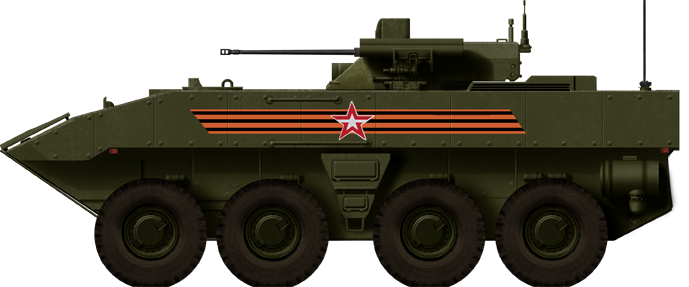
VPK-7829 K17 (IFV variant) presented in May 2015.
Gallery
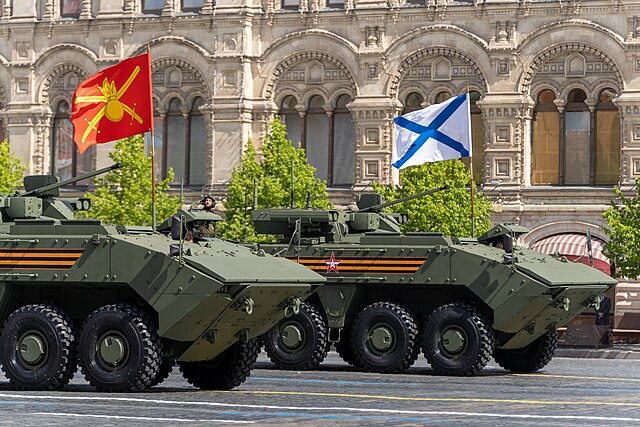
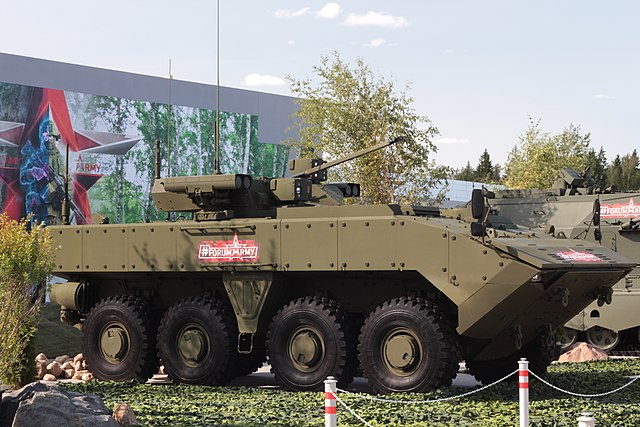
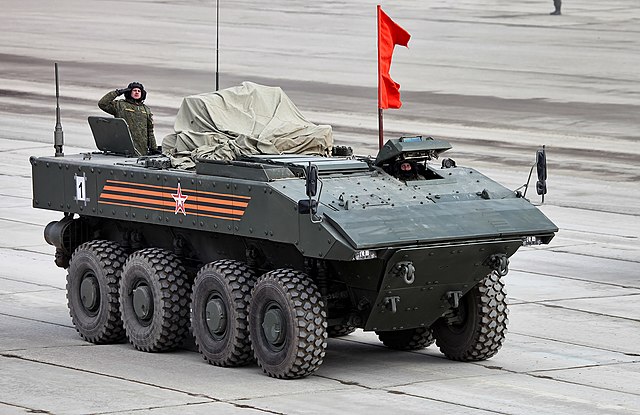


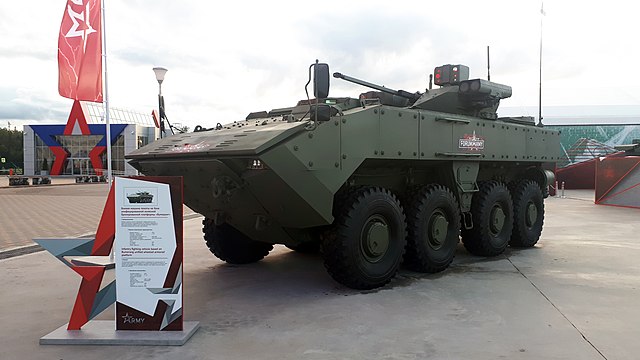
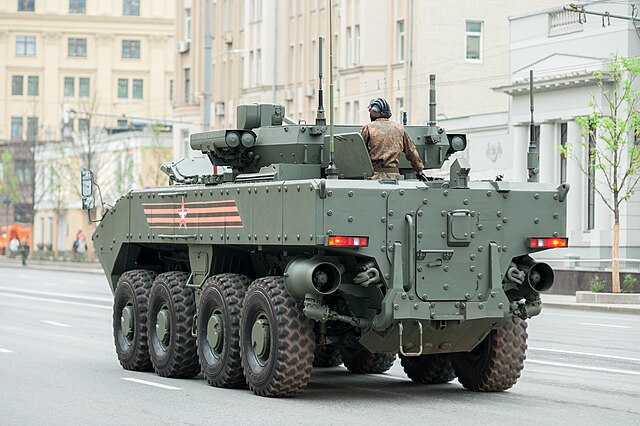
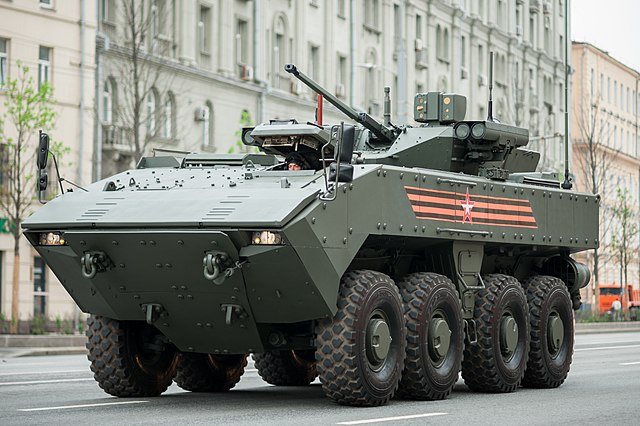
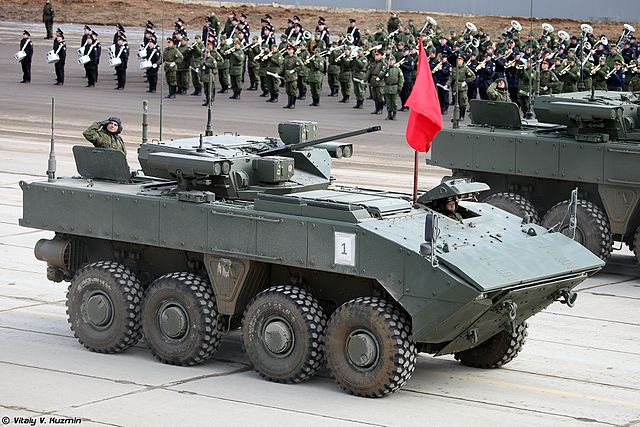
Related links
tass.ru/armiya-i-opkvpk-news.ru
lenta.ru/news
ria.ru
seriya-site-anons.
rg.ru
lenta.ru
lenta.ru/news/2012/02/21/bumerang
ria.ru/
rostec.ru/
tass.ru/armiya-i-opk
vpk.name
milindcom.ru
wiki.ru
More cc photos
On en.wikipedia.org

Modern Tanks
Modern MBTs posters

Denel Bagder (2018)

Type 16 MCV (2016)

Gepard 1A2 last rounds 2011

SANDF

Russian AFVs

Main Battle Tanks
